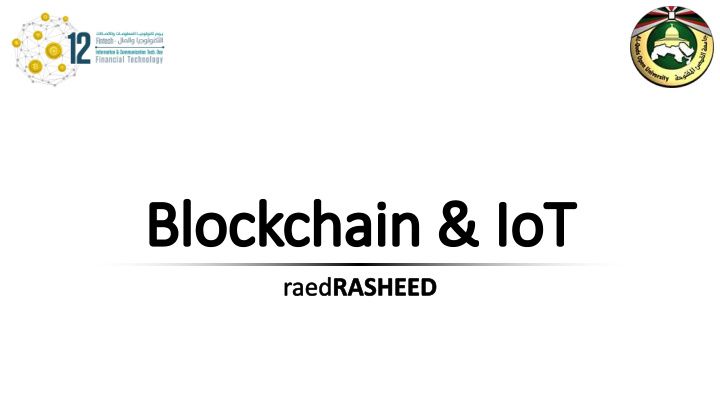



The Blockchain is an incorruptible digital ledger of economic transactions that can be programmed to record not just financial transactions but virtually everything of value. Don & Alex Tapscott, authors Blockchain Revolution 2
0 1 2 3 4 5 6 3
0 1 2 3 4 5 6 0 1 2 3 4 5 6 0 1 2 3 4 5 6 0 1 2 3 4 5 6 0 1 2 3 4 5 6 4
0 1 2 3 4 5 6 0 1 2 3 4 5 6 0 1 2 3 4 5 6 0 1 2 3 4 5 6 0 1 2 3 4 5 6 5
0 1 2 3 4 5 6 0 1 2 3 4 5 6 0 1 2 3 4 5 6 0 1 2 3 4 5 6 0 1 2 3 4 5 6 6
0 1 2 3 4 5 6 0 1 2 3 4 5 6 0 1 2 3 4 5 6 0 1 2 3 4 5 6 0 1 2 3 4 5 6 7
IoT is billions of embedded computers, sensors, and machines all connected online. Cuno Pfister, Getting Started with the Internet of Things, 1 st Edition 8
The number of connected devices to expand from 20 billion today to 30 billion by 2020 to 80 billion by 2025 AI is the future of the IoT - IBM Internet of Things 9
Why combine Blockchain and IoT? 1. There is the issue of oversight. 2. The use of encryption and decentralized storage means that data can be trusted by all parties involved in the supply chain. 3. Allow the creation of agreements which will be executed when conditions are met. 4. Improving the overall security of the IoT environment. 10
Blockchain benefits for IoT 1. Decentralization and scalability: remove central points of failures and bottlenecks. 2. Identity: ability to identify every single device 3. Autonomy: devices are capable of interacting with each other without the involvement of any servers. 4. Reliability: enables sensor data traceability and accountability. 11
Blockchain benefits for IoT 5. Security: information and communications can be secured if they are stored as transactions of the blockchain. 6. Market of services: easily deployed and micro-payments can be safe. 7. Secure code deployment: secure-unchangeable storage, code can be safety and securely pushed into devices. 12
Crypto Generation: Bitcoin 1 st , Ethereum 2 nd , IOTA 3 rd 14
Bitcoin basic and simple 15
Bitcoin • The first Crypto created by Satoshi Nakamoto. • Can be sent from user to user on the peer-to-peer bitcoin network directly, without the need for intermediaries. • Released in January 2009. • Blockchain technology. • No BTC double-spends. • Transaction integrity. • Mining = Approving. 16
Ethereum smart contract 17
Ethereum • Proposed in late 2013 by Vitalik Buterin. • Supports a modified version of Bitcoin . • Smart contracts are high-level programming abstractions using Solidity that are compiled down to EVM (Ethereum Virtual Machine). • You can talk to a machine. 18
IOTA is a distributed ledger designed to record and execute transactions between machines in the IoT ecosystem. https://www.investopedia.com/terms/i/iota.asp 19
Crypto Generation: Three generations were innovated since 2008. • IOTA • New idea [ Tangle ] not [ Blockchain ]. • IOTA Tangle (DAG) Directed Acyclic Graph, which holds transactions. • Machine to machine economy. • Faster transaction. • No miners No fees. 20
21
22
23
24
26
27
28
Smart Tree with 2 nd Generation of Blockchain (Smart Contract) ERC-20 29
• Your mobile connect the SmartTree automatically . • Pay for electricity (Solar Energy)) automatically . • Pay for Internet connection automatically . • Machine to machine payment using crypto . 30
31
Thanks… 32
Recommend
More recommend